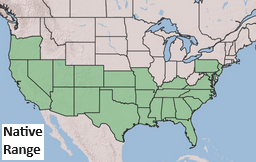Frog Fruit
Phyla nodiflora
Click here to download a PDF of this plant information page (for printing).

Sun Exposure: Full Sun, Part Sun
Season of Interest: Spring, Summer, Fall
Bloom Time: June - October
Bloom Color: White and Purple
Height: 3 to 6 in.
Spread: 12 in.
Spacing: 16 in.
Water Needs: Average
Maintenance: Low, Mow if it becomes "leggy".
Soil Type: Clay, Loam, Sandy, Rocky
Soil pH: Acidic, Neutral, Alkaline
Soil Drainage: Well drained
Pests: None
Diseases: None
Wildlife: Bees, Butterflies

Description:
Frog Fruit, also known as Turkey Tangle, is a vigorous, spreading ground cover native to the Southern United States. It's a tough one, able to survive a wide range of conditions and soil types. It tolerates both drought and flooding, but does best with occasional deep watering in full sun to part shade. it flowers heavily over a long period with charming little heads of mauve-pink, lavender and white blossoms, attracting a wide assortment of bees and butterflies. This dense, carpeting plant makes a serviceable ground cover or lawn-like replacement, tolerating moderate foot traffic and occasional mowing. It will die back in the winter, but quickly recovers in spring. For more information see:
nativebackyards.com/frog-fruit
Care and Growing Tips:
Frog fruit is very easy to care for and gets easier as it establishes itself and spreads. The main requirements to remember when caring for frog fruit are: 1) water when first planted; 2) fertilize in spring to increase blooms; 3) prune back or mow after flowering if it gets "leggy". Frog fruit is loved as a ground cover because it is adaptable to the amount of sun it need and can be grown in full to part shade and do amazingly well. It will do best and produce the most blooms in full sun, but there will be no harmful effects when it comes to vigor, and your frog fruit will not suffer any more or fewer diseases if planted in partial shade; it will just produce fewer blooms. For best results, plant frog fruit in well-draining soil. In the wild, frog fruit grows anywhere from roadside ditches, to beach dunes, to newly burnt forests. Yet another reason it is so loved as a landscape plant is its versatility in dealing with various soil conditions. You will not have to add amendments to perfect your soil when planting frog fruit. Watering frog fruit is the largest concern for caring for the plant until it is established. While drought tolerant, the species appreciate extra irrigation during dry, hot weather. Frog fruit enjoys warm weather and takes to the humidity well. In warm conditions, it will remain evergreen or semi-evergreen during warm winters. It can thrive during droughts and do well in dry and humid climates but does not tolerate cold. Keeping frog fruit to its suggested USDA zones of 7-11 will ensure your plants thrive and stay attractive year-round. Fertilize (NPK 2-6-4) yearly in the spring, to encourage flowering.